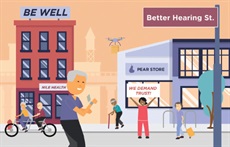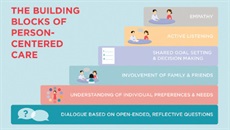This is the second in a series of four articles about the future of hearing care, based on the Future Hearing Journeys report by the Ida Institute.
Oxford traces the word “well-being” to the early 1600s, but the modern wellness movement didn’t start in earnest until the 1980s. Now, it’s a global, 1.5 trillion-dollar industry that’s shaping the future of hearing care. So, is the wellness philosophy compatible with good hearing care? And if so, how can hearing care professionals support their clients’ well-being?

Photo/courtesy Ida Institute. Wellness, future, well-being, integrative care, person-centered care.

The Six Elements of Person-Centered Care. Used with permission from the Ida Institute. Wellness, future, well-being, integrative care, person-centered care.
The quest for well-being is shaping future hearing care. The Ida Institute’s Future Hearing Journeys report 1 defines “hearing health as well-being” as a trend that will significantly influence hearing care over the next 5-10 years. The report also identifies that people with hearing loss want to see “a focus on overall health and well-being” in the coming years. And the Copenhagen Institute for Futures Studies has identified a focus on well-being as a key megatrend shaping health care over the next decade.
McKinsey & Company estimates today’s global wellness market at more than US$ 1.5 trillion and predicts growth of 5-10 percent per year. Their Future of Wellness survey from 2020 found, “consumers care deeply about wellness—and their interest is growing. In a survey of roughly 7,500 consumers in six countries, 79 percent of the respondents said they believe that wellness is important, and 42 percent consider it a top priority.” 2
WHAT ARE WELLNESS AND WELL-BEING?
Definitions for wellness and well-being are slippery at best. In writing for the Royal Society of Public Health, McMahon, Williams, and Taspsell note, “Wellness and well-being are essentially contested concepts since they are everyday terms and usually carry an assumed level of agreement. Their meaning seems to typify this; they can be quite subjective depending on the context in which they are used. In that sense it relates well to Humpty Dumpty’s remarks in Alice in Wonderland that the use of a word ‘means just what I choose it to mean, neither more nor less.’” 3
But we can say that, typically, both wellness and well–being focus on the whole person, including mind, body, and spirit. Generally, wellness emphasizes harmony or health of each of the three areas, while well-being emphasizes satisfaction or happiness with them. Wellness and well-being can also include the individual environments and situations of people that can have a profound effect on health and happiness.
People are realizing that catering to their whole self not only makes them healthier, but also happier. Wellness is no longer the domain of the upwardly mobile hanging around spas and yoga studios; wellness is about people from all walks of life being happy and living more fully. And in that sense, hearing and communication play a significant role as they impact a person’s relationships, safety, occupation, and community involvement as well as contributing to comorbidities like dementia, diabetes, and the loneliness pandemic.
BEYOND THE MEDICAL
Clinicians can support wellness through a holistic approach to hearing care, which, according to Mosby’s Medical Dictionary, is “complete or total patient care that considers the physical, emotional, social, economic, and spiritual needs of the person, his or her response to illness and the effect of the illness on the ability to meet self-care needs.” 4
Of course, hearing care professionals are not expected to be psychologists, spiritual leaders, surgeons, financial advisers, counselors, friends, and audiologists rolled into one convenient package. Holistic hearing care includes only medical treatment and counseling as it relates to hearing, communication, and balance issues. ASHA’s audiology scope of practice for the counseling process, says it, “includes interactions related to emotions, thoughts, feelings, and behaviors that result from living with hearing, balance, and other related disorders.” No more, no less.
But there are ways hearing care professionals can better address the whole person during appointments. Afterall, it isn´t just the future of hearing care, it is person-centered and best practice.
KNOW THE PERSON TO TREAT THE PERSON
A Future Hearing Journeys survey of 302 hearing care professionals found counseling and person-centered care among the opportunities they see for themselves in the future.
Person-centered care is more than being nice and attentive. It is a specific approach with an attached set of values used to guide and structure appointments and relationships between professionals and their clients. Professionals can work holistically by employing the six elements of person–centered care, shown in the Figure, in their appointments. 5 Person-centered care (PCC) ensures that people are equal and active partners in the management of their hearing difficulties. Designed around the individual, PCC focuses on and is respectful of people’s needs and preferences, involves family and other communication partners, and includes shared decision-making and goal setting. Counseling through an evidence-based PCC approach creates appointments that move strict emphasis from hearing difficulties—as with a medical model—towards a biopsychosocial model. This helps clients improve communication so they can participate in and enjoy the things that matter to them.
To support the biopsychosocial model, a best-practice approach to find audiological solutions to a client’s social challenges is to apply the World Health Organization’s International Classification of Functioning, Disability and Health (ICF) framework. The framework helps facilitate discussions about a person’s needs or wants, and ways to improve their quality of life.
THE SIX ELEMENTS OF PCC
Well-being is subjective and, like happiness, can only truly be appraised by the individual. To help someone achieve well-being necessitates understanding their needs and preferences as they determine them.
Bridgitte Harley, Director and Audiologist at the Hearing Clinic in the UK says, “Everyone experiences their hearing journey in a unique and personal way, so being acknowledged and treated as an individual is important. Many clients will see having their needs and preferences assessed as an important, motivating factor for participating in their care and may feel more inspired to embark on their journey to better hearing health. Understanding needs and preferences helps you provide better care which leads to a better quality of life for your client and those close to them.”
Open-ended questions can help to uncover lifestyle and communication hopes, needs, and expectations from clients. This is where professionals can discover the unique circumstances and personal challenges of their clients and provide counseling and care specific to the whole individual, rather than based only on their medical diagnosis.
Involving family and friends in appointments provides another perspective on a client’s lifestyle and communication challenges and presents an opportunity to address difficulties expressed by the communication partners.
Shared goal setting and decision-making ensures that clients agree with and support the treatment objectives. Their involvement is shown to increase treatment adherence and lead to better outcomes.
Empathy is essential for treating the whole person because it strengthens connections and relationships, making people feel valued and cared for. And satisfying relationships are a cornerstone of well-being.
Kris English, Professor Emeritus, Audiology, at The University of Akron in the US explains active listening is directly related to empathy and, “requires minimal input on our part. Head nods and neutral comments such as ‘I see,’ and encouragement like, ‘Could you give an example?’ give the speaker permission to continue talking, and work through the particular difficulty.”
FROM INTERDISCIPLINARY TO INTEGRATIVE CARE
General practitioners are often the first contact of people experiencing health issues and are accustomed to doing screenings and referring patients on to specialists. But hearing care professionals can expect to play a wider role in health screening in the future, as client expectations for total care grow.
In Audiology Practices, David Zapala, Senior Consultant in Otorhinolaryngology and Chair of the Audiology Division at the Mayo Clinic Florida, tells us that more than 100 diseases and conditions could be discovered in an audiological evaluation. And when “the signs and symptoms develop in the otologic sphere, the audiologist has a special responsibility to screen for the condition and initiate referrals as needed.”
And in From Healthy Hearing to Healthy Living: A Holistic Approach, Campos and Launer encourage screenings beyond audiological ones to be administered. 6 “Asking about recent falls to identify recurrent fallers, administering basic tasks of mobility function known to be associated with falls risk, administering tests that screen for mild cognitive impairment, and/or asking about subjective, uncorrected vision problems” are just some of the things they suggest.
But referrals and multidisciplinary cooperation won’t be enough in future hearing care where interdisciplinary teamwork will increasingly become the norm among hyperconnected health care professionals and organized networks and shared buildings will unite diverse specialists—including integrative care practitioners. Integrative care combines conventional medicine and complementary practices like acupuncture, massage, and yoga in a structured way. The Mayo Clinic already leads the way in this area as the largest integrated, not-for-profit medical group practice in the world.
PROMOTE THE EXPERIENCE, NOT THE TECH
Another megatrend identified by the Copenhagen Institute for Futures Studies is immaterialization—the changes in our perceptions and values that include a greater focus on value over volume and experience over physical goods.
You may have heard that millennials prefer to nourish their minds, bodies, and spirits with experiences over material things. But the extensive behavioral economics work by psychologist Thomas Gilovich shows that most people in fact get more happiness through experiential purchases than material ones. 7 It’s not just millennials. Other literature builds on that to explain why: Experiential purchases facilitate more social connection, are more closely tied to the self, and are experienced more on their own terms, not with respect to how they compare with other experiential purchases.
While hearing technology is a material purchase, the challenge for hearing care professionals is to regard hearing devices as bridges to experiences. Connecting hearing and communication to life, rather than to technology, taps into the preferences and desires of the people around the world shaping the wellness trend.
A CONTINUING EVOLUTION OF HEARING CARE
Hearing care professionals have always been concerned with well-being—they just didn’t have a name for it or evidence to guide their approach. But as hearing care evolves and the efficacy of holistic care and the benefits of well-being are better understood, professionals are evolving as well. They are part of the change and adapting to it, in the service of their clients. Ultimately, the wellness philosophy is good for patients, good for professionals, and good for society at large. Wellness is the future of hearing care.


